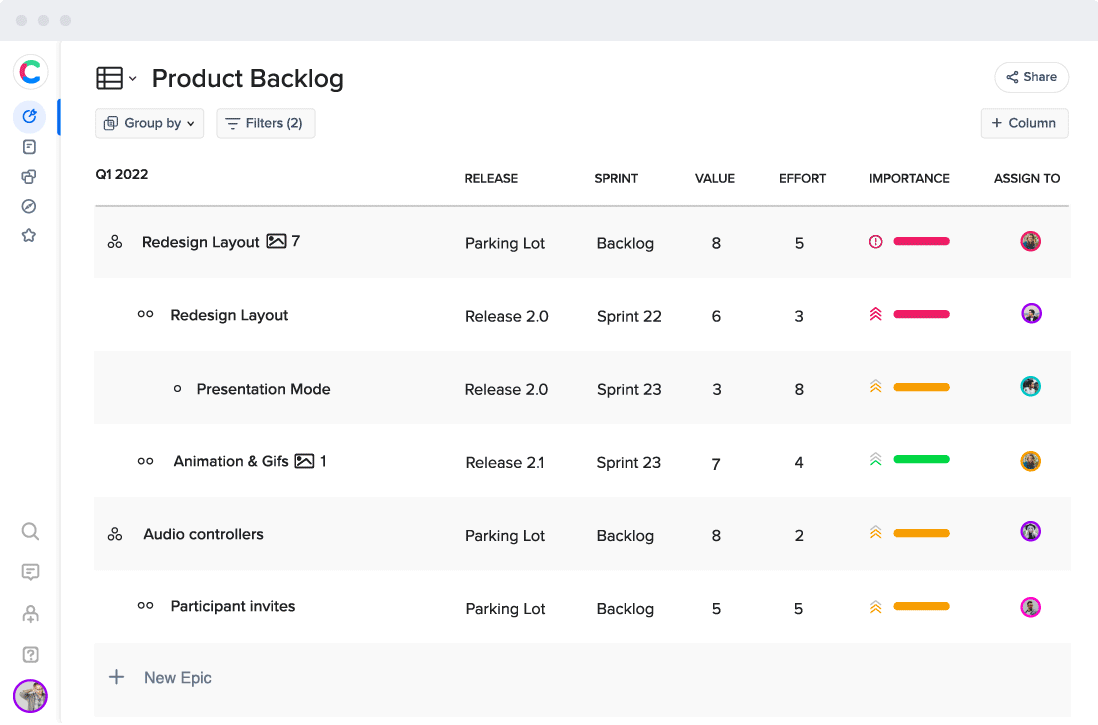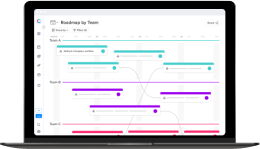Home > Blog > 8 Examples of Winning Product Development Strategies
8 Examples of Winning Product Development Strategies

Your Goal Should Be Developing Innovative Products – Not an Innovative Product Development Strategy
Tech analysts and entrepreneurs have pointed this out a zillion times, but it’s worth repeating here: Steve Jobs wore the same outfit every day so that he’d have fewer small decisions taxing his mind, leaving more time and mental energy for the big, important decisions. The same goes for your product development strategy.
Your goal is to bring innovative products to the market. And one smart way to clear your team’s path and enable more innovation is to create predictable, repeatable routines for everything else. That way, like Steve Jobs reaching into his closet yet again for a black turtleneck and jeans, you can devote more time to coming up with innovative product ideas.
Fortunately, when it comes to developing new products, thousands of product teams around the world have tried and refined countless approaches and methodologies. You can benefit from all that hard work and trial and error by leveraging these teams’ best processes for your own product development.
Choosing one of the proven product development strategies below (or, better yet, trying several to find the one that best suits your company) will help ensure your team can devote more focus and energy to finding creative solutions to market problems – and less trying to figure out what approach to take each time you’re ready to develop a new product.
The Step-by-Step of Product Development Doesn’t Need to Be Complicated, Either
Before we jump into our strategy examples, we want to point out that this post will not cover the detailed steps of product development. And fortunately, that process doesn’t need to be mysterious or difficult, either. If you’re looking for a step-by-step guide to bringing a new product from idea through market launch, read our blog: Demystifying the Product Development Process, and check out our on-demand webinar: Uncomplicating Product Strategy.
8 Examples of Winning Product Development Strategies
Not all of the strategies below will work for your organization. But each of them has worked for some companies – including, as we’ll explain, with some of the most successful technology companies in the world. So we believe studying all of these product development strategies will be worth your time.
1. Start with a great product, then find your customers. (Apple)
This is a controversial approach, particularly in the current era when customer demands seem to be the primary driver behind new technology products.
But no less a company than Apple takes this approach to new product development – working on the Steve Jobs assumption that customers typically don’t know what new solutions they want until they see those solutions.
With this development strategy, if your team has done the thinking and research, and you’ve determined that you’ve got a hit product idea – even if the market isn’t already asking for it – you might want to give it a try.
2. Work backwards from your customer’s problem. (Amazon)
This approach, developed by Amazon, is 180 degrees from Apple’s product-centered development strategy. The Amazon “work backwards” approach asks product teams to start their new product development process by writing an internal press release announcing the unveiling of the new product. And that news release must persuasively describe the customer persona, the problem the product will solve for that customer, how the product will solve the problem, and how customers can buy the product.
That means you’ll first need to think through your customer’s wants, needs, and challenges, and then conceive a solution that helps address those issues.
Among the many benefits of this approach, Amazon product executives say, are that it forces product teams to articulate their solution clearly, in plain language, to describe only the solution’s core function (avoiding scope creep) and keeping everyone on track if the product gets the green light. If a piece of functionality is not in the press release, the team will have to stop and ask why they’re building it.
3. Partner with your competitors to give users more choice. (Oracle)
According to a 2022 article from tech-analyst firm KuppingerCole, database Oracle has transitioned to a new product development strategy in recent years. For many years into the cloud era, Oracle continued selling only client-side software applications and systems.
But as more customers began shifting to cloud data providers, such as Microsoft, Amazon, and Google, Oracle’s product teams realized it might make more sense to partner with those companies – allowing customers to continue using their familiar Oracle solutions but in the cloud with trusted providers.
As the article notes, Oracle’s new development strategy could be described as “Why not both?” Rather than making customers choose between Oracle’s solutions and a cloud competitor whose software they might not like as much but that offers cloud hosting, Oracle now lets customers choose both.
4. Take the product-led approach to growth. (Slack)
With the product-led strategy, you’ll develop and launch a product with the primary goal of getting as many people to use it as possible – for free, in most cases. The second part of this product development strategy is to design the product such that users gain more benefit from it by introducing it to other users.
Examples of the product-led strategy include Slack, Calendly, and Zoom. The apps are designed specifically to spread organically. And eventually, the businesses whose employees are using these tools go to the product teams behind them and ask for enterprise-level versions.
For useful tips on implementing this approach to product development, check out our blog: 50 Shades of Product-Led Growth.
5. Expand beyond your core product line. (Adobe)
This is another controversial development strategy, because it seems to go against conventional product management wisdom that you should learn your personas’ challenges and focus intensely on solving those challenges. Under that way of thinking, turning your attention to new markets or solutions might seem like distractions from your core expertise.
But Adobe’s product team has bet big on this strategy, creating new products for its key buyer persona – creators – that are outside the company’s traditional design-related solutions. The Adobe Experience Cloud, for example, offers those creatives who have bought Adobe’s design tools for years more functionality than ever – including budgeting, marketing automation, and customer analytics.
6. Develop solutions that you can pivot when needed. (Netflix)
Netflix is a great example of this development strategy. The company set out to become a leading content provider, but in its early days, neither streaming technology nor the bandwidth to people’s homes were sufficient to allow TV and movies over the internet. (But the company’s name was Netflix from the beginning – evidence they had the streaming vision all along.)
So, the Netflix team started as a DVD-rental service using the mail as its infrastructure for sending and receiving rentals from users. But they built the customer base, data, and relationships with entertaining studios and production companies that Netflix would need to pivot quickly to the streaming leader when the technology caught up with the team’s vision.
7. Keep your product – especially your MVP – simple. (Pinterest)
This product development strategy, famously used by Pinterest, involves narrowing the scope of your product to a few valuable capabilities. In Pinterest’s case, the early version of the product had only one feature – allowing users to visually bookmark things that interested them, using the familiar pin button.
One of the great things about following this approach is that it makes it easy for users to tell others about your solution. And in a sense, that’s another way of using our fourth strategy above – taking the Product-Led Approach.
8. Experiment and be willing to fail. (Every successful company ever.)
Whatever product development strategy you choose, you should also leave your team room to experiment, take some risks, and leave open the possibility that a new product or feature will fail with users.
If you play only the sure bets with your products, you could miss those unexpected moments where something you’ve built becomes a surprise winner with a segment of the market – even if neither that segment nor even your own team realized how valuable the solution would be.
Track and Analyze the Progress of Your Product Development Strategy Using the Right Tools
Finally, one best practice that applies to every product development strategy here is to make sure you’re keeping track of all data your team generates – from your earliest product ideas to your roadmap, design mockups, user feedback on your MVP, and capacity levels for the next iteration of the product. And ideally, you’ll want to sync and be able to access all that product content in a single digital hub – like the craft.io product management platform.

Try craft.io for free



